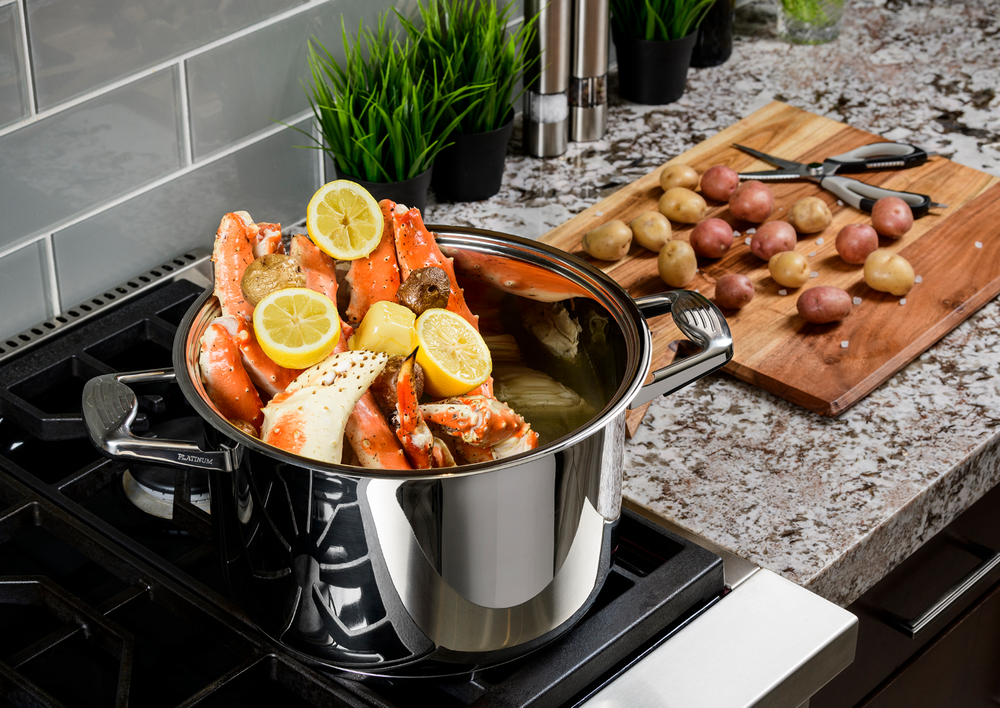How to Deep Fry in a Stock Pot: A Barbecue Enthusiasts' Guide
Written By James Morgan
Welcome, barbecue enthusiasts! If you're wondering how to deep fry in a stock pot, you've come to the right place. Deep frying is an art, and when done correctly, it adds a delightful crunch to your food that is hard to resist. This article will guide you through the process of deep frying using a stock pot, providing all the tips and tricks you'll need for a successful fry.
The Basics of Deep Frying in a Stock Pot
Before diving in, let's cover the basics. Deep frying involves submerging food in hot oil, cooking it quickly at high temperatures. A stock pot can be an excellent vessel for this purpose due to its deep and spacious design. But there's more to it than just filling your pot with oil and heating it up.

Choosing the Right Stock Pot
The first step in mastering how to deep fry in a stock pot is selecting the right pot. Ensure your stock pot is large enough to allow the food to move around freely without overcrowding. A pot that is too small can lead to uneven cooking and oil spills. If you're unsure about the size of your stock pot, check out this helpful guide.
Material and Construction
The material of your stock pot also matters. Opt for a pot made from stainless steel or cast iron for even heat distribution. These materials can withstand high temperatures and reduce the risk of hot spots, which can burn your food.

Prepping Your Equipment
To get started, you'll need a few basic tools besides the stock pot. A deep frying thermometer is essential to monitor the oil temperature. Additionally, have a slotted spoon or tongs on hand to safely handle the food. Make sure you also have a cooling rack or paper towels to drain the excess oil after frying.
Safety First
Safety should always be a priority. Keep a fire extinguisher nearby, and never leave the hot oil unattended. Avoid overcrowding the pot, as it can cause oil to overflow and potentially ignite.

Heating the Oil
Fill the stock pot with oil, making sure to leave enough space for the food to be submerged without overflowing. Heat the oil gradually to the desired temperature, usually between 350F and 375F. Use your deep frying thermometer to keep a close eye on the temperature, as overheating can lead to oil fires.

The Frying Process
Once your oil has reached the perfect temperature, it's time to start frying. Carefully lower the food into the hot oil using a slotted spoon or tongs. Fry small batches to ensure even cooking and maintain the oil temperature. Overcrowding the pot can cause the oil temperature to drop, resulting in greasy and undercooked food.
Cooking Times
Different foods require different frying times. For example, chicken wings might take around 10-12 minutes to cook, while french fries could take 3-5 minutes. Always keep an eye on the color and texture of your food, and use a meat thermometer for meats to ensure they reach a safe internal temperature.
Draining and Serving
After frying, carefully remove the food from the oil and place it on a cooling rack or paper towels to drain the excess oil. Season immediately while the food is hot, as this will help the seasoning stick better. Serve your crispy, delicious creations to your guests and enjoy!
Troubleshooting Common Deep Frying Issues
Deep frying can be tricky, and even experienced cooks can encounter issues. Here are some common problems and how to address them:
Oil Temperature Fluctuations
If your oil temperature fluctuates, it can result in uneven cooking. Make sure to use a reliable thermometer and adjust the heat as needed to maintain a consistent temperature.
Greasy Food
Greasy food is often a result of frying at too low a temperature. Ensure your oil is hot enough before adding the food. Additionally, avoid overcrowding the pot, as this can lower the oil temperature.
Burnt Food
If your food is burning, the oil may be too hot. Lower the heat slightly and monitor the temperature closely. Also, keep an eye on the cooking time to prevent overcooking.
Conclusion
Now that you know how to deep fry in a stock pot, it's time to put your skills to the test. With the right tools, careful monitoring, and a bit of practice, you'll be able to create delicious, crispy fried foods that will impress your friends and family. For more tips and insights, you can check out this expert guide on stock pots. Happy frying!
FAQs
Can I reuse the oil for deep frying?
Yes, you can reuse the oil, but it's essential to strain it after cooling to remove any food particles. Store the oil in a cool, dark place and use it within a month. Avoid reusing oil that has turned dark or has a rancid smell.
What is the best oil for deep frying?
Peanut oil, vegetable oil, and canola oil are popular choices for deep frying due to their high smoke points. These oils can withstand high temperatures without breaking down and imparting off-flavors to your food.
How do I know when the food is done?
Use a deep frying thermometer to monitor the oil temperature and a meat thermometer for meats. Additionally, look for a golden-brown color and crispy texture. Cutting into the food to check for doneness can also be helpful.
As an Amazon Associate, I earn from qualifying purchases.



